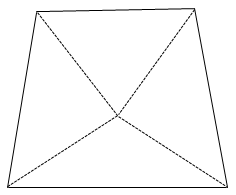Conductance matrix for quadrilateral elements
To calculate the conductance matrix, each quadrilateral element is divided into four triangle sub-elements, by connecting the corners to the CG of the quadrilateral element as shown in the example.

An additional four conductances, between the quadrilateral CG and boundary elements, are created by minimizing the root mean square value of the conductances between the boundary elements. Using the software default settings, conductance between the CG and boundary elements are balanced by:
where:
- Li is the length of the boundary element.
- Di is the distance between the element CG and the CG of the boundary element.
- Θi is the angle between the line connecting the CG of the element to the boundary element and the surface normal of the boundary element.
The weighting factors for the conductances from the CG to the boundary elements are defined by assuming a parabolic temperature distribution within the element. The conductance matrix for quadrilateral elements has ten conductances.
